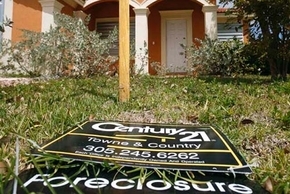Mortgage defaults decline, but Nevada still ranks high
LOS ANGELES — Six years after the start of the foreclosure crisis, American homeowners are paying their mortgages like the housing crash never happened although Nevada borrowers still rank in the top five for delinquencies.
First-time delinquent home loans fell to 0.84 percent of the 50.2 million mortgages in March, the first month below 1 percent since 2007, before a wave of defaults led to the financial crisis, according to a report Monday by Lender Processing Services. The rate of first-time defaults, defined as loans that went from performing to at least 60 days delinquent, peaked at 2.89 percent in January 2009.
Florida had the highest rate of non-current mortgages with 18.2 percent of loans either delinquent or having received a foreclosure notice, followed by New Jersey, Mississippi, Nevada and New York. While Florida’s problem loans declined over the last year, the number increased 5.8 percent in New Jersey and 6.1 percent in New York. All three are judicial states, where homes languish in foreclosure more than 1,000 days while waiting to be repossessed.
The decline in new problem loans shows that the recovering U.S. economy, falling unemployment and rising home prices, combined with more than four years of banks’ tightening lending standards, are propelling the worst real estate crash since the Great Depression into the rearview mirror.
“Mortgage quality is improving rapidly,” Mark Zandi, chief economist for Moody’s Analytics Inc. said in a telephone interview from his office in West Chester, Pa. “Once we’re able to work through this last bulge of foreclosed property, which I think we’ll be able to do over the next 18 to 24 months, mortgage credit quality is going to look absolutely beautiful.”
Mortgages at least 30 days delinquent or in some stage of foreclosure fell to 5 million in March, down from a peak of 7.7 million in January 2010, according to Lender Processing Services, a real estate information service based in Jacksonville, Fla. That’s still more than double the 2.2 million non-current mortgages of January 2005, when the housing market was rising toward its peak.
Tight lending standards have made it harder for borrowers to obtain mortgages, helping drive down default rates while reducing the homeownership rate in the first quarter to 65 percent, the lowest since 1995.
The Federal Housing Administration, which offers loans to buyers with downpayments as low as 3.5 percent, has steadily raised its credit scores. In the third quarter of 2012, the most recent available, 97 percent of FHA borrowers had credit scores above 620 of a possible 850. In the last quarter of 2006, only 53 percent had a score above 620.
New mortgage default rates are highest among so-called “underwater” borrowers, who have negative equity because they owe more on their home than the balance of their loan, said Herb Blecher, senior vice president at LPS Applied Analytics.
The new default rate was 4 percent for borrowers who owe at least 50 percent more than the value of their home compared with 0.6 percent for owners with equity, according to today’s report.
The number of home loans with negative equity fell to about 9 million or 18 percent of homes with a mortgage in January, the report said. That’s down 41 percent from a year earlier and 47 percent lower than the peak of 17 million loans in February 2011.
U.S. home prices climbed at the fastest pace since May 2006, rising 9.3 percent in February from a year earlier, according to an April 30 report by the S&P/Case-Shiller index of property values.
There’s a “feeding frenzy in housing” as Americans seek to take advantage of prices about 29 percent below their 2006 peak and mortgage rates near record lows, said Ross Perot Jr., 54, chairman of Dallas-based real estate company Hillwood Development Co., in a telephone interview. Perot’s father, H. Ross Perot, twice ran for president as an independent candidate.
“The big picture: this economy is coming back,” Perot said from Newport Beach, Calif., where he was breaking ground on a condo project backed by his Dallas-based company. “The American people are very shrewd and they realize it’s a great time to borrow to buy a home because pricing is very cheap.”
The average rate for a 30-year fixed mortgage dropped to 3.35 percent last week, down from 3.84 percent a year ago as the Federal Reserve has bought $85 billion of bonds to stimulate the economy. The average 15-year rate is a record low 2.56 percent.
Demand is also rising as more Americans find jobs. The unemployment rate fell to 7.5 percent in April, its lowest rate since December 2008, the Labor Department reported May 3.
While new defaults have declined, loans that are at least 90 days delinquent account for a growing share of the non-sperforming mortgage pie: 62 percent this year compared with 30 percent in 2005, according to Lender Processing Services. The late-stage delinquency loans are increasingly concentrated in so-called judicial states that require court approval for foreclosures.
“The new problems coming into the system have alleviated,” Blecher said in a telephone interview. “It’s really about addressing what’s still in the pipeline.”






















